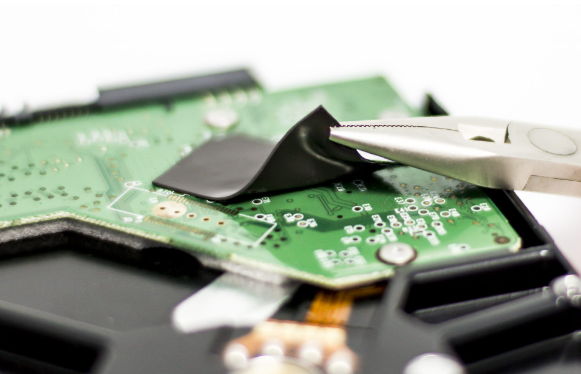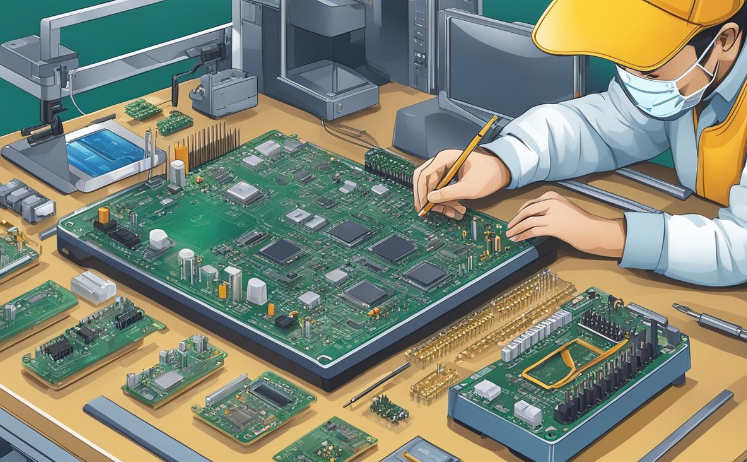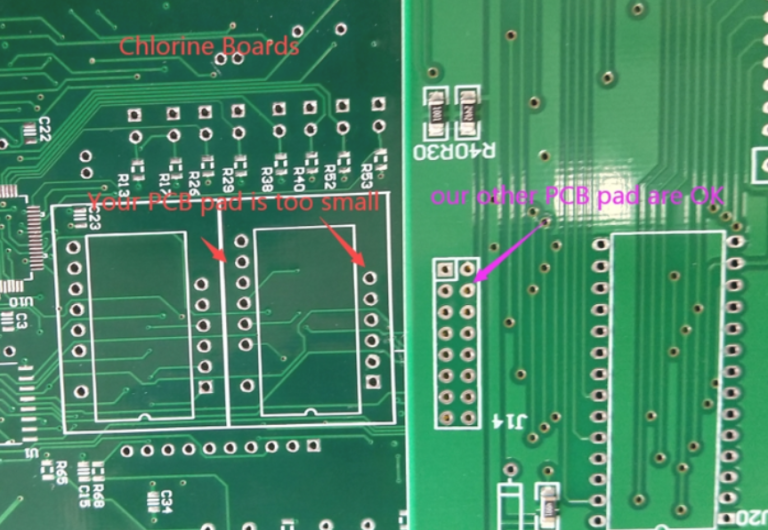Thermal pad in pcb
Importance Of Thermal Pads In PCB Design
In the realm of printed circuit board (PCB) design, the importance of thermal management cannot be overstated. As electronic devices become increasingly compact and powerful, the heat generated by components can pose significant challenges.
One critical element in addressing these challenges is the thermal pad.
Thermal pads play a pivotal role in ensuring the reliability and longevity of electronic devices by effectively managing heat dissipation.
To begin with, thermal pads are materials placed between heat-generating components and heat sinks or other cooling mechanisms.
Their primary function is to facilitate the transfer of heat away from critical components, thereby preventing overheating. Overheating can lead to a myriad of issues, including reduced performance, component failure, and even catastrophic damage to the entire device. Therefore, incorporating thermal pads into PCB design is essential for maintaining optimal operating temperatures and ensuring the overall stability of electronic systems.
Moreover, thermal pads are particularly crucial in high-power applications where components such as processors, power transistors, and LEDs generate substantial amounts of heat. In these scenarios, the efficiency of heat transfer becomes a determining factor in the performance and reliability of the device. Thermal pads, typically made from materials with high thermal conductivity such as silicone, graphite, or ceramic-filled polymers, provide a low-resistance path for heat to travel from the component to the heat sink. This efficient heat transfer helps maintain the component’s temperature within safe operating limits, thereby enhancing its performance and extending its lifespan.
In addition to their thermal conductivity properties, thermal pads also offer electrical insulation.
This dual functionality is particularly beneficial in PCB design, where space constraints often necessitate the close placement of components. By providing both thermal management and electrical insulation, thermal pads help prevent short circuits and other electrical issues that could arise from the proximity of heat-generating components to other sensitive parts of the circuit.
Furthermore, the use of thermal pads can simplify the assembly process of electronic devices.
Unlike thermal pastes or greases, which require precise application and can be messy, thermal pads are easy to handle and apply. They come in various shapes and sizes, allowing for customization to fit specific components and PCB layouts. This ease of use not only reduces the risk of application errors but also speeds up the manufacturing process, contributing to overall cost savings.
Another significant advantage of thermal pads is their ability to accommodate surface irregularities between the component and the heat sink.
PCBs and electronic components often have microscopic surface imperfections that can impede effective heat transfer. Thermal pads, being conformable, can fill these gaps, ensuring maximum contact area and thereby enhancing thermal conductivity. This adaptability makes thermal pads a versatile solution for a wide range of applications and component configurations.
In conclusion, the importance of thermal pads in PCB design cannot be understated.
They are indispensable for effective thermal management, ensuring that electronic components operate within safe temperature ranges. By facilitating efficient heat transfer, providing electrical insulation, simplifying assembly, and accommodating surface irregularities, thermal pads contribute significantly to the reliability, performance, and longevity of electronic devices. As technology continues to advance and the demand for more powerful and compact devices grows, the role of thermal pads in PCB design will only become more critical.

How To Choose The Right Thermal Pad For Your PCB
Selecting the appropriate thermal pad for your printed circuit board (PCB) is a critical decision that can significantly impact the performance and longevity of your electronic device. Thermal pads serve as an interface material that facilitates the transfer of heat from electronic components to heat sinks or other cooling mechanisms. Therefore, understanding the key factors involved in choosing the right thermal pad is essential for ensuring optimal thermal management.
To begin with, it is important to consider the thermal conductivity of the pad.
Thermal conductivity, measured in watts per meter-kelvin (W/mK), indicates how efficiently the pad can transfer heat. Higher thermal conductivity values generally mean better heat dissipation. However, it is crucial to balance this with other factors such as the thickness of the pad. Thicker pads may offer better gap-filling capabilities but can also impede heat transfer if the thermal conductivity is not sufficiently high. Therefore, a comprehensive evaluation of both the thermal conductivity and thickness is necessary to achieve the desired thermal performance.
Another critical factor to consider is the compressibility of the thermal pad.
Compressibility refers to the pad’s ability to conform to the surfaces it interfaces with, thereby minimizing air gaps that can act as thermal insulators. A highly compressible pad can accommodate surface irregularities and ensure better contact between the heat-generating component and the heat sink. This is particularly important in applications where components have varying heights or where the surface finish is not perfectly smooth. Consequently, selecting a thermal pad with appropriate compressibility can enhance the overall thermal interface performance.
In addition to thermal conductivity and compressibility, the operating temperature range of the thermal pad must also be taken into account.
Different materials have varying temperature tolerances, and it is essential to choose a pad that can withstand the operating conditions of your specific application. For instance, silicone-based thermal pads are known for their wide temperature range and flexibility, making them suitable for a variety of applications. On the other hand, if your application involves extremely high temperatures, you may need to consider alternative materials such as graphite or ceramic-based pads.
Furthermore, the electrical insulation properties of the thermal pad should not be overlooked.
In many applications, it is crucial to ensure that the thermal pad does not conduct electricity, thereby preventing potential short circuits. Silicone-based pads often provide good electrical insulation, but it is always advisable to verify the dielectric strength of the material to ensure it meets the requirements of your application. This is particularly important in high-voltage applications where electrical isolation is paramount.
Additionally, ease of installation and reworkability are practical considerations that can influence your choice of thermal pad.
Some pads come with adhesive backing, which can simplify the installation process but may complicate rework if components need to be replaced or repositioned. Non-adhesive pads, while potentially more challenging to install initially, can offer greater flexibility for future modifications. Therefore, evaluating the installation and rework requirements of your project can help you make a more informed decision.
In conclusion, choosing the right thermal pad for your PCB involves a careful assessment of multiple factors, including thermal conductivity, compressibility, operating temperature range, electrical insulation properties, and ease of installation. By thoroughly evaluating these aspects, you can select a thermal pad that not only meets the thermal management needs of your application but also ensures the reliability and efficiency of your electronic device.
Installation Tips For Thermal Pads On PCBs
When installing thermal pads on printed circuit boards (PCBs), it is crucial to follow a series of meticulous steps to ensure optimal thermal management and device performance. Thermal pads serve as an interface material that facilitates heat transfer from electronic components to heat sinks or other cooling mechanisms. Proper installation is essential to maximize the efficiency of this heat transfer, thereby preventing overheating and potential damage to the components.
To begin with, it is important to select the appropriate thermal pad for your specific application.
Thermal pads come in various thicknesses, thermal conductivities, and material compositions. The choice of thermal pad should be based on the thermal requirements of the components, the gap between the component and the heat sink, and the mechanical properties needed for the application. Once the appropriate thermal pad has been selected, the next step is to prepare the surfaces of both the PCB and the heat sink.
Surface preparation is a critical step in the installation process.
Both the PCB and the heat sink surfaces should be clean, dry, and free of any contaminants such as dust, oils, or residues. Contaminants can impede the thermal conductivity of the pad, reducing its effectiveness. To clean the surfaces, use isopropyl alcohol and a lint-free cloth. Gently wipe the surfaces and allow them to dry completely before proceeding to the next step.
After ensuring that the surfaces are clean, carefully measure and cut the thermal pad to the required size.
The pad should cover the entire surface area of the component that requires cooling, but it should not extend beyond the edges of the component. Using a sharp blade or scissors, cut the thermal pad to the precise dimensions needed. It is advisable to handle the thermal pad with clean gloves to avoid contaminating it with oils from your skin.
Next, peel off the protective backing from one side of the thermal pad.
Align the pad with the component on the PCB, ensuring that it is properly centered. Gently press the pad onto the component, applying even pressure to ensure good adhesion and to eliminate any air bubbles that may be trapped between the pad and the component. Air bubbles can significantly reduce the thermal conductivity of the pad, so it is important to ensure a smooth, bubble-free application.
Once the thermal pad is securely in place on the component, peel off the protective backing from the other side of the pad.
Carefully align the heat sink with the component and press it firmly onto the thermal pad. Again, apply even pressure to ensure good contact between the heat sink and the thermal pad. It may be helpful to use a small roller or a flat tool to apply uniform pressure and to further eliminate any air bubbles.
Finally, secure the heat sink to the PCB using the appropriate mounting hardware.
This may include screws, clips, or adhesive, depending on the design of the PCB and the heat sink. Ensure that the heat sink is firmly attached and that there is no movement or shifting, as this could compromise the thermal interface.
In conclusion, the installation of thermal pads on PCBs requires careful attention to detail and adherence to best practices. By selecting the appropriate thermal pad, preparing the surfaces properly, and ensuring a smooth, bubble-free application, you can achieve optimal thermal management and enhance the performance and longevity of your electronic components.

Comparing Thermal Pads And Thermal Paste For PCB Applications
When it comes to managing heat dissipation in printed circuit board (PCB) applications, the choice between thermal pads and thermal paste is a critical decision that can significantly impact the performance and longevity of electronic components. Both thermal pads and thermal paste serve the primary function of enhancing thermal conductivity between heat-generating components and heat sinks, but they do so in different ways and come with their own sets of advantages and disadvantages.
Thermal pads are solid, pre-formed sheets made from materials with high thermal conductivity, such as silicone or graphite.
They are designed to fill the gaps between heat sources and heat sinks, providing a consistent and reliable thermal interface. One of the primary advantages of thermal pads is their ease of application. Unlike thermal paste, which requires careful spreading to ensure even coverage, thermal pads can simply be placed onto the component, making them particularly user-friendly. This ease of use reduces the risk of application errors, which can lead to suboptimal thermal performance or even damage to the components.
In contrast, thermal paste, also known as thermal grease or thermal compound, is a viscous substance that must be applied manually.
It is typically composed of a polymerizable liquid matrix filled with thermally conductive materials such as metal oxides or ceramic particles. The primary advantage of thermal paste lies in its ability to conform to microscopic surface irregularities, thereby providing a more intimate contact between the heat source and the heat sink. This can result in superior thermal conductivity compared to thermal pads, especially in applications where the surfaces are not perfectly flat.
However, the application of thermal paste requires a certain level of skill and precision.
An uneven application can lead to air pockets, which are poor conductors of heat and can significantly reduce the effectiveness of the thermal interface. Additionally, thermal paste can dry out over time, potentially leading to a decrease in thermal performance. This necessitates periodic reapplication, which can be a drawback in long-term applications where maintenance is challenging.
On the other hand, thermal pads offer a more stable and durable solution.
They do not dry out or degrade over time, making them ideal for applications where long-term reliability is crucial. Moreover, thermal pads can also provide electrical insulation, which is an added benefit in certain applications where electrical isolation is required. However, their thermal conductivity is generally lower than that of high-quality thermal paste, which can be a limiting factor in high-performance applications.
In summary, the choice between thermal pads and thermal paste for PCB applications depends on various factors, including the specific thermal requirements, the ease of application, and the long-term reliability of the solution. Thermal pads offer simplicity and durability, making them suitable for applications where ease of use and long-term stability are paramount. Conversely, thermal paste provides superior thermal conductivity and is better suited for high-performance applications where maximizing heat dissipation is critical. Ultimately, the decision should be based on a careful assessment of the specific needs and constraints of the application, ensuring that the chosen thermal interface material provides the optimal balance of performance, reliability, and ease of use.





